Breaking Ice with Skuas, Seals, Penguins, and Whales
This evening at 6 p.m., the Palmer cast off its lines, weighed anchor, started its great engines rumbling, and set off through the pack ice. After a few safety briefings, everyone flooded out onto the decks for a display of sea ice and wildlife like nothing I have seen before. The temperature was about 30 degrees, but a chilly wind blew over the bow. I put on my warm clothes: a red safety “float coat” over my jacket, a wool hat pulled down over my ears, and the soft fleece mittens my mom had sent me before the trip began. Read on through the slideshow to find out what we saw today:
- Scientists spent the morning running last errands at McMurdo. The Palmer’s dock is a 5 to 10 minute walk from the Crary science lab, where many of our scientists have been working. Here, Rutgers’s Josh Kohut, chief scientist for our cruise, saves time by riding a bike. The bikes are thoughtfully provided by McMurdo Station to be shared among staff, and bike rides on the gravel road offer a short respite from busy preparations.
- On board the Palmer, other scientists were busy getting their equipment set up and locked down so they won’t fall out of place in rough seas. Here, Dr. Allen Milligan of Oregon State University sets up a device called a fluorometer, which will help him understand how phytoplankton make adjustments to get the right amount of sunlight as they grow. His results will help to make global measurements of photosynthesis that are done by satellite more accurate.
- After we departed, crewmembers led us through a series of orientations. We learned how to put on survival suits, how to calmly pack 76 people at a time into a big orange lifeboat, and what to wear on the main deck to avoid getting soaked or injured by heavy equipment. Here, marine technician Jeremy Lucke delivers a briefing while standing on a ‘CTD,’ one of the basic tools of oceanography. We’ll lower it through the water while sensors measure salinity, water temperature, and depth. The gray bottles around the edge capture water for the scientists to use in experiments. You’ll be seeing more of this device soon.
- The Palmer is a powerful ship, but she’s more research ship than icebreaker. To get through the thick ice around Ross Island she depends on a Swedish vessel named the Oden, which some say is the finest icebreaker in the world. This year the sea ice was extra tough, and it took the Oden four days to break a path in to McMurdo. Here we’re following the Oden (just visible as a dark line at the horizon) back out to open water.
- The broken ice in our track offers a route in for marine wildlife—I started calling it ‘Seal Avenue’ after seeing a few hundred Weddell seals hauled out on the edges or lounging on floating chunks in our path. Despite the approach of our 308-foot orange behemoth, most seals just looked up at us inquisitively—even this one that was just off our starboard side. (Thanks to the skill and attention of our captain and crew, I’m happy to report that no seals were harmed in the making of this post.)
- Next we started seeing penguins—first, three emperor penguins standing four feet tall on the ice, then a group of seven Adélies trudging single file in the far distance. (The two in the photo are Adélies.) These hardy birds breed in great numbers all around the Antarctic continent—an estimated 10 million of them. Two of the world’s largest colonies are in the Ross Sea, one on Ross Island and the other at Cape Adare, where we’re headed in a few days.
- As the pack ice thinned and we approached open water, the Oden moved aside and let us pass so it could return to McMurdo. The Swedish crew waved at us and our captain sounded several long blasts on the ship’s horn in farewell. Now, for the next month, it’s just us on our floating laboratory, hotel, and kitchen on the sea.
- We saw two species of whales: minkes and orcas (pictured). First came the minkes, resting their delicate snouts on ice floes and breathing clouds of steam into the air. Minkes have short dorsal fins and they feed by straining plankton from the water through baleen-filled mouths. If you see a tall, skinny dorsal fin like this one, it’s an orca, or killer whale. This one swam the length of our ship at a distance of only a hundred feet or so, giving us a good look at its dappled yellow-and-black sides, scarred from the ice.
- When penguins slide along on their tummies, it’s called tobogganing. They push with their feet, steer with their flippers, and glide on their thick chests, which are cushioned by a combination of breast muscle and blubber. From time to time they seem to get tired of it and pop to their feet in an instant. Then they wobble into a run, raising their flippers for balance. It’s possible you have a kid sister or brother who looks like this when they run.
- Our trip through the ice was a thrilling way to begin our month at sea. At one point the food chain almost materialized right before our eyes. A group of Adélies came porpoising straight toward an orca. A South Polar skua, always on the lookout for a meal, flew in low just in case the orca made a move for one of the penguins. But the whale swam on past, the penguins sped up and launched themselves onto the safety of the ice, and the skua folded its wings and settled back down.
As everyone filed back into the ship, microbiologists, chemists, engineers, and computer programmers alike were abuzz over what they’d seen. It was 10:30 at night and many had hours of work to do before bedtime, but no one was complaining. Being witness to these animals—living in such numbers in such an outlandish world—was a treat as well as an inspiration.
These hundreds of seals, penguins, and whales are marvelous examples of why we’re here. They wouldn’t live in the Ross Sea if these waters weren’t teeming with plankton, krill, and fish. Our ship’s science team has come here to take a microscopic look at these rich waters and learn why and how they’re so productive. When they’re finished, we may find we understand the penguins and whales better, too.
Now it’s 3 a.m. and we’re back among the ice floes. The Palmer shears past loose floes with a thud and a scrape down the hull; we occasionally lurch to one side on big impacts. Outside, patio-sized sheets of ice roll on our bow wave. As they pass by the portholes, I can see they’re criss-crossed by the footprints of penguins.


 January 19, 2011
January 19, 2011 
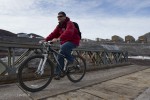
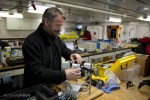
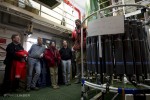
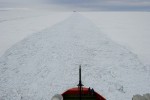

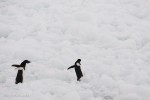
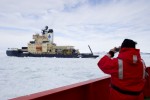
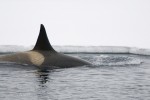
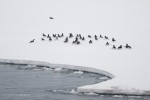
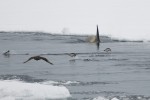







15 Responses to “Breaking Ice with Skuas, Seals, Penguins, and Whales”